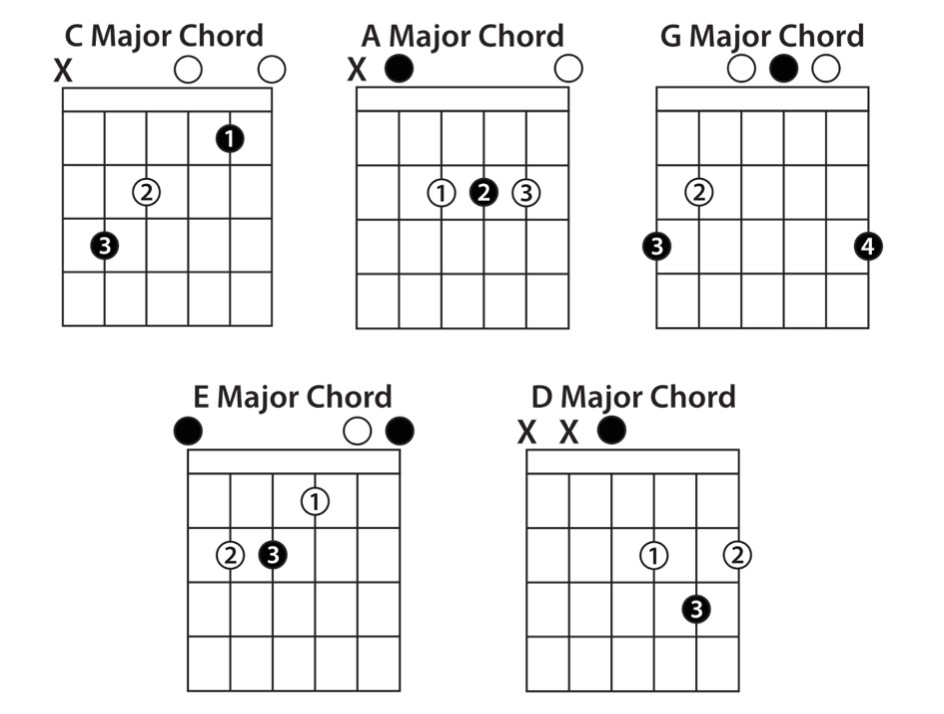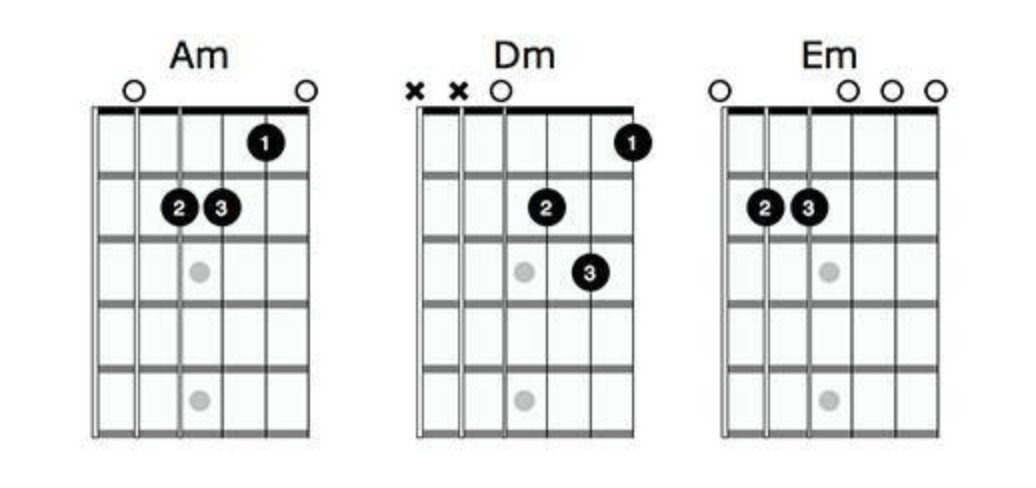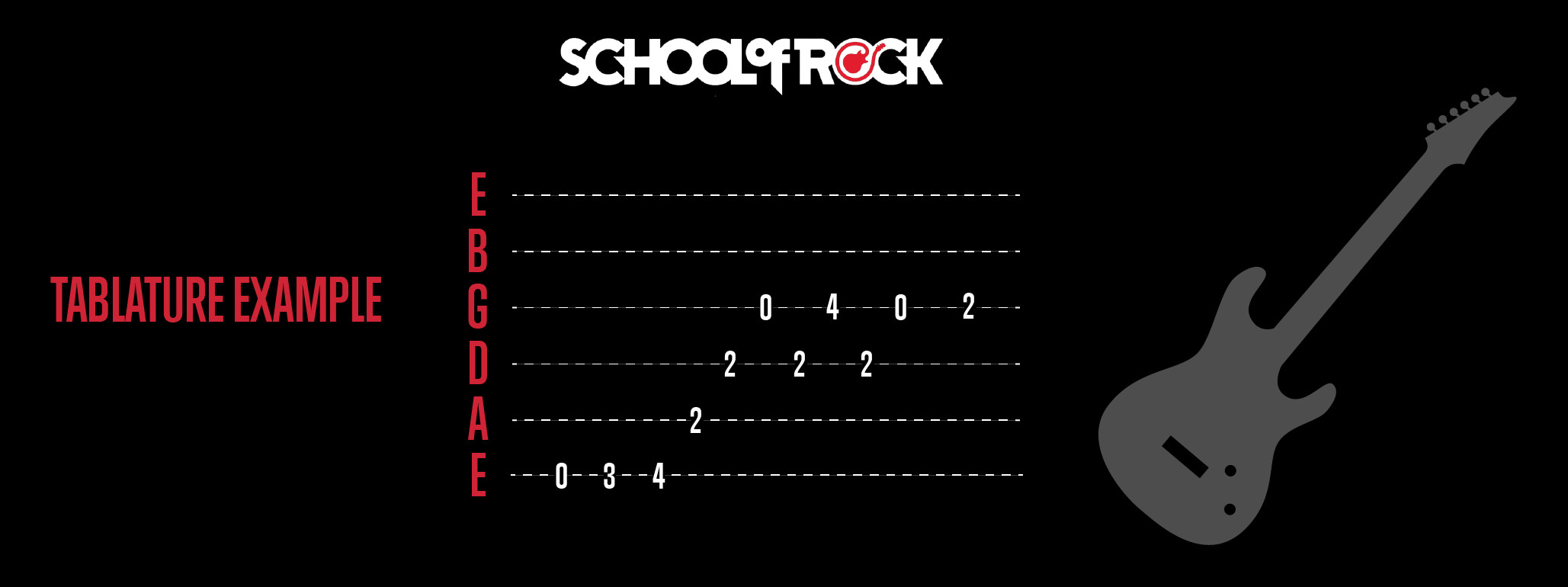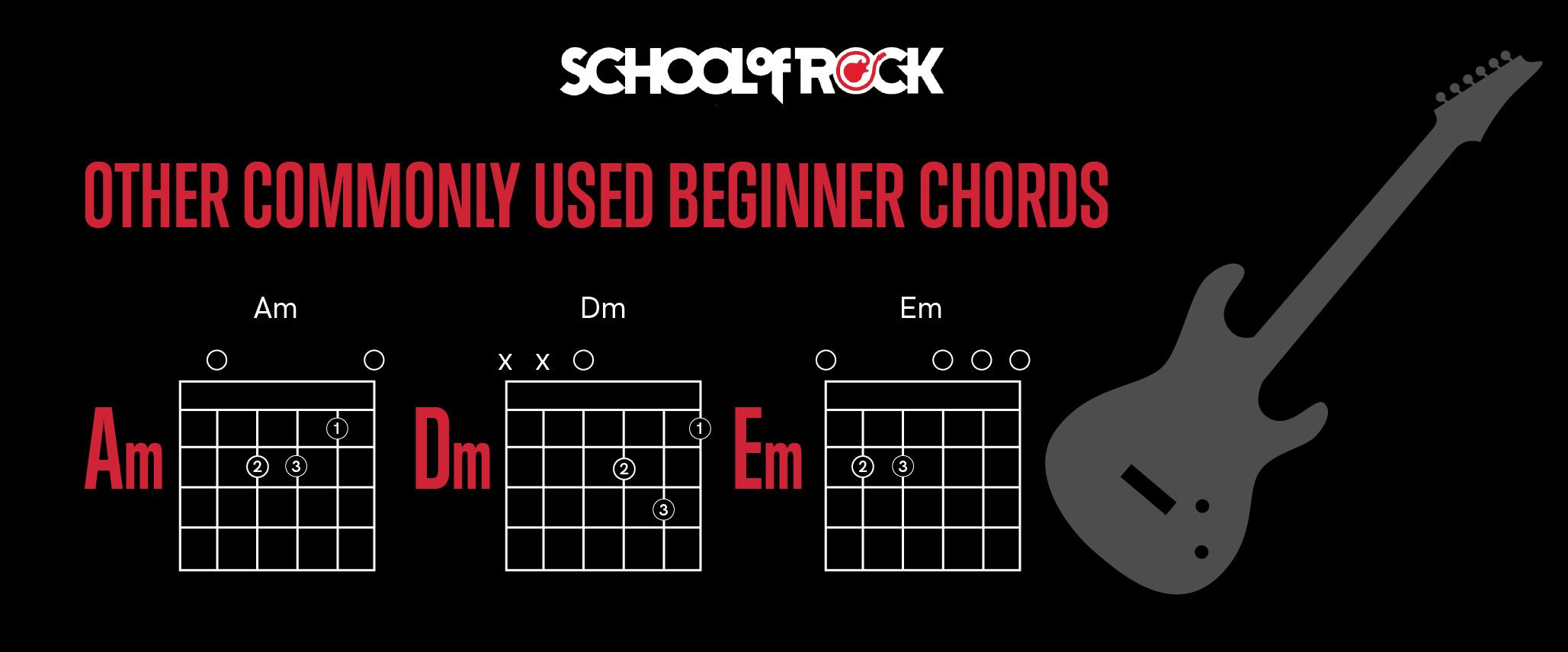Picking up a guitar for the first time is exciting, but it can quickly become overwhelming when you ask yourself, “What do I play first?”. Many beginners find themselves lost, unsure where to even place their fingers. If this sounds familiar, don’t worry! Learning guitar chords is the perfect place to start your musical journey. Chords are the building blocks of harmony in music. They provide rhythm, depth, and make music feel complete. While instruments like drums and bass focus on rhythm and depth, most instruments, especially the guitar, use chords to create rich musical textures.
In this guide, we’ll explore some of the Easiest Chords To Learn On Guitar, offering tips and tricks to master them quickly. We’ll also look at some popular songs you can start playing right away using just these simple chords.
At institutions like School of Rock, the emphasis is on practical application and performance. Students learn not just in lesson rooms but also by playing in front of live audiences. Whether you aspire to be a lead guitarist focusing on melodies and solos, or a rhythm guitarist driving the song with chords and strumming patterns, understanding chords is absolutely essential. And if you’re just starting and need help choosing your first guitar, take a look at this helpful guitar-buying guide for some valuable advice.
What are Chords and Why are They Important?
Simply put, a chord is a group of notes played together simultaneously, creating a harmonious sound. Think of chords as the colors in a painter’s palette. Just as colors bring paintings to life, chords add richness and emotion to music. Without chords, music would sound very basic and lack depth.
For guitarists, learning chords is the foundation upon which everything else is built. Chords allow you to:
- Play Songs: The vast majority of songs are built around chord progressions. Knowing just a few chords opens up a world of musical possibilities.
- Accompany Vocals: Whether you want to sing along or accompany another singer, chords provide the perfect harmonic backdrop.
- Understand Music Theory: Learning chords is your first step into understanding how music works. It’s the gateway to more advanced concepts and techniques.
- Have Fun! Most importantly, learning chords is fun and rewarding. You’ll quickly be able to play recognizable songs and feel a sense of accomplishment.
Types of Beginner-Friendly Chords
When you’re starting out, the world of guitar chords can seem vast and complex. However, there are a few types of chords that are particularly easiest chords to learn on guitar for beginners. We’ll focus on these to get you started:
Open Chords: The Best Starting Point
Open chords are often the first chords taught to beginner guitarists, and for good reason. The term “open” refers to the fact that these chords utilize open strings – strings that are played without fretting any notes. This makes them simpler to play as you don’t need to fret every string. Open chords typically involve fewer frets and fingers compared to other types of chords, making them physically easiest chords to learn on guitar.
A common set of open chords that beginners learn are the CAGED chords. We’ll explore these in more detail shortly. Open chords are versatile and form the basis of countless songs across genres.
Power Chords: Simple and Powerful
Power chords are another excellent choice for beginners. Often associated with rock and heavier music genres, power chords are known for their simplicity. They typically involve only two or three strings and fewer frets, making them very finger-friendly and easiest chords to learn on guitar physically.
Power chords are particularly popular on electric guitars, where they can be easily distorted to create a powerful, driving sound. However, they sound great on acoustic guitars too. Despite their simplicity, power chords are incredibly versatile and can be used in a wide range of musical styles.
Barre Chords: A Bridge to More
Barre chords are a bit more challenging than open and power chords initially, but they are incredibly useful as you progress. A barre chord involves using one finger to press down multiple strings across a single fret, effectively acting as a “barre”.
While barre chords can be tougher on beginner fingers initially, mastering the technique opens up a whole new world of chord possibilities. The beauty of barre chords is that once you learn a barre chord shape, you can move it up and down the neck to create different chords. We’ll touch on barre chords briefly, but for now, we’ll primarily focus on the easiest chords to learn on guitar: open and power chords.
Essential Open Chords for Beginners: CAGED
Before diving into playing, it’s crucial to ensure your guitar is properly tuned. Playing in tune will make the learning process much more enjoyable and rewarding. If you’re struggling with tuning, resources like this guide to tuning a guitar can be a lifesaver!
Now, let’s explore the CAGED system of open chords. CAGED is a mnemonic device, with each letter representing a common open chord: C, A, G, E, and D. These chords are fundamental and widely used in popular music, and they are definitely among the easiest chords to learn on guitar when starting out.
The diagrams below illustrate how to play each CAGED chord. Understanding how to read these diagrams is key to learning chords effectively.
 Open Guitar Chords for Beginners
Open Guitar Chords for Beginners
Understanding Chord Diagrams
Chord diagrams are your roadmap to playing chords. They provide a visual representation of the guitar fretboard and tell you exactly where to place your fingers. Here’s how to decipher them:
- Orientation: The diagram is read horizontally, representing the guitar as if you were holding it upright in front of you. The top line is the thickest string (low E), and the bottom line is the thinnest string (high E).
- Strings and Frets: Vertical lines represent the strings, and horizontal lines represent the frets. The top horizontal line is the guitar nut (the start of the fretboard).
- X and O: An “X” above a string indicates that the string should not be played (muted). An “O” above a string means it’s an open string, played without fretting.
- Numbers: Numbers within the diagram indicate which finger to use to fret a note: 1 = index finger, 2 = middle finger, 3 = ring finger, and 4 = pinky finger.
- Finger Placement: The dots with numbers show you where to place your fingers on the fretboard. For example, in the A Major chord diagram, all fingers are on the second fret, but on different strings. The index finger is on the second fret of the D string, the middle finger on the G string, and the ring finger on the B string.
By understanding these elements, you can use chord diagrams to learn countless guitar chords. Let’s look at the CAGED chords in more detail using diagrams.
 Detailed chord diagrams illustrating the finger positions for C, A, G, E, and D major open chords, essential for beginner guitarists.
Detailed chord diagrams illustrating the finger positions for C, A, G, E, and D major open chords, essential for beginner guitarists.
Other Easy Open Chords to Learn
Beyond the CAGED chords, there are other open chords that are also considered easiest chords to learn on guitar and are frequently used in beginner songs. These include:
- E minor (Em): A melancholic sounding chord that is very simple to fret.
- D minor (Dm): Another minor chord that adds emotional depth to your playing.
- F Major (F): While slightly trickier than some open chords, a simplified version of F Major can be learned early on.
Here are diagrams for some of these additional easy open chords:
 Additional chord diagrams showcasing finger positions for other beginner-friendly open chords, expanding the beginner’s chord vocabulary.
Additional chord diagrams showcasing finger positions for other beginner-friendly open chords, expanding the beginner’s chord vocabulary.
It’s important not to confuse chord diagrams with tablature (TAB). While both are visual aids for guitarists, they represent different things. Tablature is a way to represent musical notes and their position on the fretboard in a linear format, especially for melodies and riffs. Chord diagrams specifically show you how to play chords.
 An example of guitar tablature, illustrating how it differs from chord diagrams in representing musical information for guitarists.
An example of guitar tablature, illustrating how it differs from chord diagrams in representing musical information for guitarists.
Chord diagrams are incredibly valuable for learning chords efficiently. They not only show you the finger placement but often suggest the most efficient fingerings, which makes transitioning between chords smoother. With practice, these chord shapes will become muscle memory, and you’ll be able to play them without constantly referring to diagrams.
Tips for Learning Guitar Chords
Learning guitar chords takes practice, but following these tips will make the process smoother and more effective, helping you master the easiest chords to learn on guitar quickly:
- Fret Close to the Fret: On the guitar neck, you’ll see metal bars separating each fret. Position your fingers just behind these bars (closer to the soundhole). Fretting closer to the fret requires less pressure and produces a clearer sound. Experiment to find the sweet spot, usually in the middle or slightly behind the fret.
- Use Your Fingertips: Press down on the strings with your fingertips, not the pads of your fingers. This gives you more focused pressure and avoids muting adjacent strings. Keep your fingers arched, like a “C” shape, to ensure you’re only pressing down the intended strings and not accidentally touching others.
- Play Each String Individually: After forming a chord, strum each string separately, starting from the thickest (low E) to the thinnest (high E). This helps you identify if any strings are buzzing or muted. If a string doesn’t sound clear, adjust your finger position until it rings out cleanly. This troubleshooting step is crucial for developing good technique.
- Practice Fretting and Unfretting: Practice transitioning into and out of chords. Form a chord, strum it, then lift your fingers off, and then try to form the chord again. You can even hover your fingers just above the fretboard in the chord shape while unfretted, so your hand gets accustomed to the shape. This exercise builds muscle memory and speeds up chord changes.
Songs to Play with Easy Chords
One of the most rewarding aspects of learning guitar is being able to play songs! Fortunately, many popular songs use simple chord progressions that are perfect for beginners. Here are some songs that utilize the CAGED chords and other easy open chords, making them fantastic choices for practicing the easiest chords to learn on guitar:
- Sweet Home Alabama by Lynyrd Skynyrd: A classic rock anthem using just three chords: C, G, and D.
- Bad Moon Rising by Creedence Clearwater Revival: Another three-chord wonder in the key of D, using G, D, and A.
- Love Me Do by The Beatles: A timeless Beatles hit in the key of G, featuring G, C, and D chords.
- Eleanor Rigby by The Beatles: A slightly more complex but still beginner-friendly Beatles tune in Em, using C and variations of Em.
- Time Of Your Life by Green Day: A popular acoustic song in G, using G, C, Cadd9, and D5 power chords (you can substitute a regular D major chord for simplicity).
- Island in the Sun by Weezer: A catchy tune with four chords throughout: Em, Am, D, and G. The bridge section introduces power chords, offering a chance to transition to those later.
- Boulevard of Broken Dreams by Green Day: Another Green Day hit in Fm, using Em, G, D, and A chords. Power chords are also used towards the end, providing further practice opportunities.
More Popular Songs for Beginner Guitarists:
- Hey There Delilah by Plain White T’s
- Hallelujah by Leonard Cohen
- Redemption Song by Bob Marley
- Smoke on the Water by Deep Purple (Main riff can be simplified to power chords)
- Stairway to Heaven by Led Zeppelin (Intro and simpler sections)
- Hotel California by Eagles (Intro and simpler sections)
Power Chords vs. Open Chords: Understanding the Difference
Power chords and open chords are both easiest chords to learn on guitar for beginners, but they have some key differences. While open chords use multiple fingers and often incorporate open strings to create fuller, richer sounds, power chords are simpler, often using just one or two fingers and focusing on a root and fifth interval.
Let’s compare an A major open chord and an A5 power chord to illustrate this. An A major chord contains the notes A, C#, and E. An A5 power chord consists of just A and E. The A major chord has a root, third, and fifth, while the A5 power chord has a root, fifth, and octave (which is the same note as the root, just higher).
Essentially, a power chord is like a simplified version of a major or minor chord, omitting the third. This omission is what makes power chords neither major nor minor – they are harmonically ambiguous. The third is the note that defines whether a chord is major or minor. Because power chords lack a third, they can be used in place of either major or minor chords, depending on the musical context.
Experiment by playing an open chord and then its power chord equivalent. Listen to the difference in sound. Open chords are generally brighter and more harmonically complex, while power chords are more raw and fundamental.
Power chords can also be seen as a stepping stone to barre chords. Some power chord shapes are played using a “barre” technique, where one finger presses down two strings on the same fret. Practicing two-string barre power chords can help develop the finger strength and technique needed for full barre chords later on.
Songs Using Power Chords
Power chords are the backbone of many rock, punk, and metal songs. They are straightforward to play and deliver a powerful, driving sound. If you are interested in rock music, power chords are definitely among the easiest chords to learn on guitar and will get you playing your favorite songs quickly.
In programs like School of Rock’s Rock 101, beginner guitarists often start with power chords to learn rock songs. Here are some examples of songs that heavily feature power chords and are great for practice:
- Wild Thing by The Troggs: A classic garage rock song primarily using A5, D5, and E5 power chords, with occasional G5.
- Let It Be by The Beatles: Surprisingly, you can play this Beatles classic using either open chords (C, G, Am, F) or power chords (C5, G5, A5, F5). Try both and hear the difference!
- Rock and Roll by Led Zeppelin: A quintessential rock anthem built around A5, D5, and E5 power chords.
- I Love Rock ‘n’ Roll by Joan Jett & The Blackhearts: A high-energy rock song using E5, A5, and B5 power chords.
- When I Come Around by Green Day: This entire song is based on power chords: F#5, C#5, D#5, and B5.
- Rockin’ in the Free World by Neil Young: Starts with power chords (E5, D5, C5) and then transitions into a mix of power chords and their open chord counterparts (Em, D, C).
 Other commonly used beginner guitar chords.
Other commonly used beginner guitar chords.
Take Your Guitar Journey Further
Now that you’ve explored some of the easiest chords to learn on guitar and seen how they can be used in popular songs, are you ready to take your guitar playing to the next level? Whether you want structured guidance or just a supportive environment, School of Rock can help.
School of Rock offers private music lessons and various music programs designed to get you started on the right foot. Programs like Rock 101 and the Performance Program bridge the gap between lessons and real-world performance. Beginners and intermediate players learn to apply what they learn in lessons to playing full songs with a band.
Through these programs and lessons, students not only develop musical skills but also gain valuable life skills like teamwork, confidence, and discipline. Many of the songs mentioned in this article are part of the curriculum in these programs, helping students master open chords, power chords, and even basic music theory in a fun and engaging way. If you’re keen to learn more, find your nearest School of Rock location and reach out to discover how they can support your musical aspirations.
About the Author:
Miranda Morales is a guitar and keyboard instructor at School of Rock Easton in Pennsylvania.
